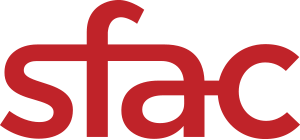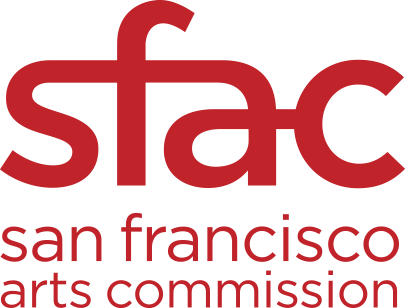1%-for-Art and Public Art Trust Quick Facts
Public Art is required of certain projects in order to enhance and enliven urban spaces and places. When so provided, the art is intended to be accessible and enjoyable by all members of the public, whether on private or public property. Public Art on private property is required to be generally accessible to the public. Public Art may take many forms, as described below.
Public Art Requirements and Section 429 of the Planning Code
Section 429 of the Planning Code requires specific projects to provide public artwork on the private property equal to 1% of project costs. Effective May 2012, in certain projects, all or part of this requirement may be satisfied by either providing accepted art of the resulting 1% valuation on-site, or paying such amount to a newly established Public Art Trust Fund (“Fund”), which is administered by the San Francisco Arts Commission.
Two Options, Two Related Purposes...
| Contributions to the Downtown Gallery of Public Art | Contributions to the Public Art Trust |
|---|---|
| Over the past two decades that the 1% for Public Art requirement has been in place, several dozen artworks have been installed as part of development projects in the downtown. These artworks are available to the public and have enriched the open spaces where they are located. A complete inventory of these artworks along with images and descriptions can be found on the Planning Department website. | The Public Art Trust was established in 2012. It is a fund into which all or part of the 1% for Public Art mandated may be deposited. The Public Art Trust will be used to enliven and activate the downtown and other core areas with ongoing and imaginative arts programming such as: temporary or permanent sculpture installations, the performing arts, light and video projects, special art events or art markets. The Trust may also be used for capital improvements to cultural facilities and restoration of City-owned artworks within the eligible districts. A primary goal of the Trust is to help these areas become cultural destinations. |
Where and When These Requirements Apply
Residential developments of 25,000 square feet or more in the C-3 District that do not have privately owned public open space (“POPOS”) may comply with the 1% requirement by depositing the Public Art Fee into the Trust. Commercial development projects 25,000 square feet or greater in the C-3, RH-DTR, TB-DTR, SB-DTR, SLI SLR, SSO, C-M, UMU, WMUG, WMUO and SALI Districts; properties that are zoned MUG, MOU, or MUR and that are north of Division/Duboce/13th streets; and all parcels zoned C-2 except for those on Blocks 4991 (Executive Park) and 7295 (Stonestown Galleria Mall) have the option of depositing funds into the Trust after satisfying stipulated on-site requirements. This requirement does not apply to residential projects outside of the C-3 District.
Three Payment Options
Project Sponsors of residential development projects in the C-3 District may use 100% of their Fee to place artwork on-site, provided they have a privately owned public open space, or they may elect to pay the Fee to the Fund. Such projects may also pay portions of their Fee to the Fund and provide on-site Artwork with the remainder.
Non-residential development projects district with POPOS ranging from 1,500 to 3,000 square feet must spend a minimum of $500,000 for on-site artwork. Projects with POPOS 3,000 square feet or greater must spend a minimum of $750,000 for on-site art. Any amount above these thresholds may be paid into the Fund or spent on on-site artwork at the discretion of the developer.
What is the process and time frame for a decision?
Prior to the issuance of the first building or site permit, the Planning Code requires project sponsors to choose between the three options of either 1) on-site art placement; 2) 100% Fee; or 3) a combination of partial Fee payment to the Fund after the on-site requirements are met.
Two Option Tracks, One or Two Approval Processes...
| Downtown Gallery of Public Art | Public Art Trust |
|---|---|
| If an on-site Public Artwork is required and/or selected, a general program is presented to the Planning Department during the initial schematic design phase of the project. The project sponsor is strongly encouraged to include the artist or art consultant in the design team as early in the project design process as possible. The on-site Public Artwork shall be installed prior to issuance of the first certificate of occupancy. The Planning Department’s website provides additional details including guidelines for providing art on-site and the full Planning Code text of the requirements for all options. |
Fund Payment: The funds will be collected by the Department of Building Inspection at the time of the issuance of the first building or site permit and deposited directly into the Public Art Trust account overseen by the Arts Commission. Project sponsors may contact the Arts Commission to discuss potential payment to the Fund to implement art projects they wish to support as part of their vision for the project and the neighborhood. If the developer wishes to use the funds in a public space within the property’s district or on-site, the Arts Commission shall issue an RFP to artists and arts organizations to submit site-specific proposals. The Arts Commission will convene a selection panel to review and pre-qualify project options from which the developer may choose. The developer is welcome to participate in the process.
For further information on what programs the Trust Fund may support, please review the guidelines. |
Credit where credit is due
Developers will be publicly credited for any project funded in full or in part through the Trust with either a plaque or signage, as well as on the Arts Commission’s website and in any materials prepared for the press.


